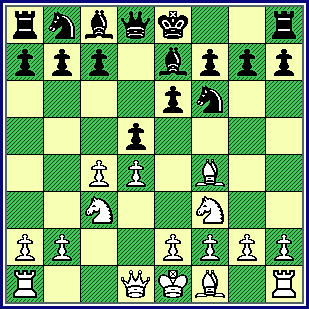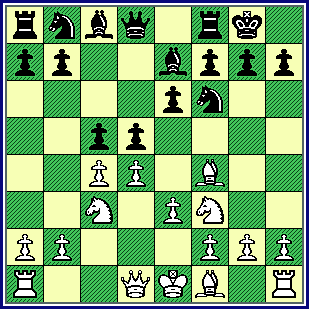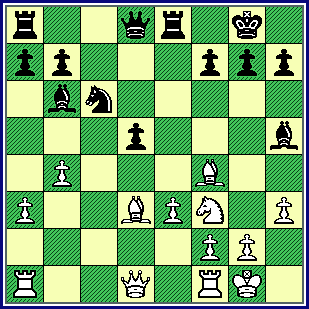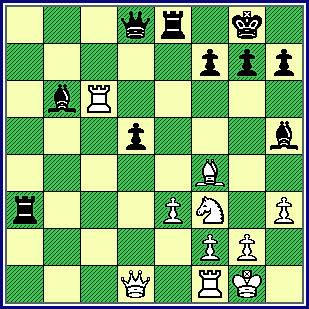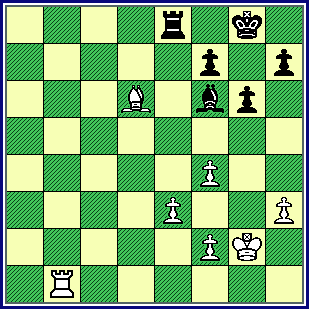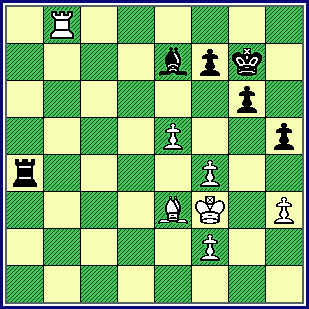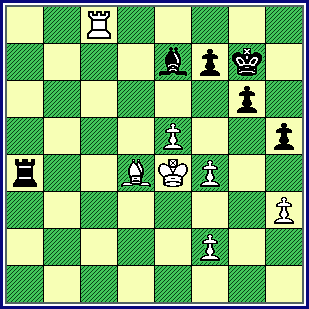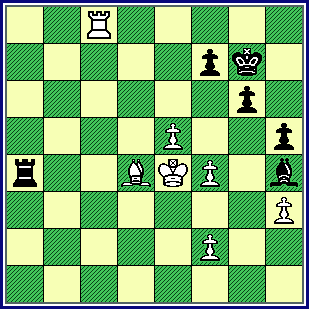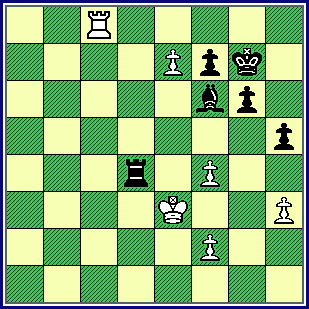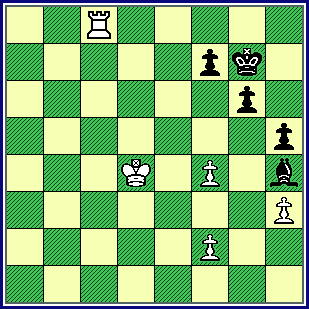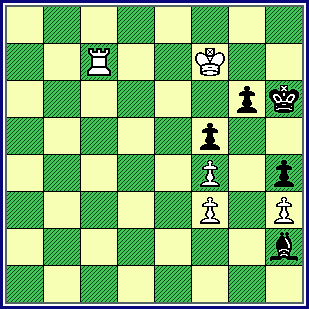GM
Peter Leko (2741) - GM Vladimir Kramnik (2770)
|
|
|
<< The Classical World Chess Championship takes place at the Centro Dannemann in Brissago, Switzerland; September 25th - October 18th, 2004. A total of 14 games will be played under classical time controls. Vladimir Kramnik is defending the title he won from Garry Kasparov in 2000 against Hungarian GM Peter Leko, who qualified at the Dortmund Candidates in 2002. >> - From a press release on the Internet.
When GM Vladimir Kramnik won the first game ... with the BLACK (!) pieces, many pundits began to predict a complete rout. But I did not buy into this theory, figuring the loss to be as much first round jitters as anything else.
Since becoming a world-class GM, Peter Leko has used the KP opening almost religiously. (I could only find two instances of Leko using the QP opening in the database ... the last of these occurred in 1998.) So to switch to a QP during the match would be a definite surprise, Leko had no history at all, (with the QP opening); to study.
<< Leko switched to 1.d4 and
surprised Kramnik with a quiet line
of the Queen's Gambit, something
that Kramnik likes to play himself.
The world champion defended well
and reached an endgame a pawn
down but with a draw looking very likely. >> - From the CB
website.
I had suggested to several friends (on the Internet) that Leko might switch to the QP, but most really did not take this idea seriously. But on the morning of the fifth game, my phone rang, and a {former} chess student from New York was calling to tell me that Leko had indeed switched to the move, 1.d2-d4.
The only question remained ... what system would Leko use now? He decided to use an early Bf4, which is a slow system that was sometimes used (on occasion) by Steinitz, Rubinstein and even Capablanca. [Of modern masters, I only really remember Victor Kortschnoij using this system at the highest levels. He even defeated Karpov in a WCS Match game with this opening.]
In my opinion, Kramnik's play looked rather spotty; his opening strategy appeared to be flawed. Soon he had an isolated pawn - Kramnik even lost a button - but most of the pundits on the Internet were still predicting a draw. (A former U.S. Champ even sent me a very detailed e-mail during the game, explaining why the game would be drawn!)
But I do not know if Kramnik tired ... or if Leko simply outplayed him. (Maybe ... just a little bit of both?) But in the end, Leko scored the full point and equalized the match score. (Possibly demoralizing the Champion, especially in a match of such a short duration?)
The ratings are those of FIDE ... and I believe are accurate here.
(This is game five of the match.)
1.d4!?, (Possibly - '!')
Just as when Bobby Fischer began
using Queen-side openings in his
(1972) match with Boris Spassky, the use of the QP had to come as
something of a surprise here.
In the post-game interview, Leko said he wanted to "torture Kramnik for a while," just as the Champ enjoys torturing his opponents from the White side of the QP-opening.
[ In games One and Three,
(of this match);
Leko
had used his favorite move:
1.e4, to open his games. (I should also
note that Leko got almost nowhere
in the opening - which may have
prompted the change to 1.d4.) ]
1...Nf6;
2.c4 e6; 3.Nf3,
A simple developing move. (And
there is nothing wrong with that.)
[ The only real question was if
Leko had played:
3.Nc3, {Diagram?}
would Kramnik have played the
<'dreaded'> Nimzo-Indian
(Defence)?
[3...Bb4] I searched
the databases very thoroughly.
I only found around
30 instances
of Kramnik using the Nimzo, and around half of these were
fast
games. (Games played at rapid or blitz
chess.)
Additionally, Kramnik's results with
this opening system were not all
that
impressive, I found several
instances of Kramnik losing with
this line.
(Like Kramnik's
loss to
FIDE Champ, GM Rustam
Ponomariov at
Wijk aan Zee,
NED; last year, {2003}.) ]
3...d5;
('!?' or even - '!')
Kramnik is VERY much a classical
player - who likes classical openings.
(Like 1.d4, d5; and also 1.e4, e5.)
Here he transposes to the most sturdy and solid way of meeting the move of 1.d2-d4, the Queen's Gambit Declined.
[ Kramnik also likes to use the
opening that begins with the
move of:
3...b6!?;
{Diagram?}
(The Queen's Indian Defence.)
I found 21 instances in the
database of Kramnik employing
this opening since the
year,
1999. (Kramnik's overall results
with this opening have been
pretty good.)
(I should go on to note while this
game represents Leko's first use
of the QP opening
in this match,
he used it in later games as well.
And in at least two of these, GM
Kramnik
did indeed use the very
respected Queen's Indian Defense.
{I began annotating this game
almost as soon as it was played.
I had no idea - when
Leko first
utilized it - if the QP was a 1-time
thing, of if Leko planned on using
it for
the rest of the match.}
Friday;
4.Nc3 Be7;
Simple - safe - and sound
development. Black's last move
also prepares castling. I would
say from a standpoint of pure
principle, that this is one of the
most solid options for Black.
[ Black could try: 4...c5!?; which I believe would lead to a "Semi-Tarrasch" system. ]
5.Bf4!?,
(Another surprise!)
{See
the diagram ... just below.}
GM Nick de Firmian - on page
# 389 of MCO (14) - calls this
particular line, ... "a {very} viable
alternative" (to the regular lines).
*********************
|
|
*********************
Many top GM's have used this system on occasion, but I know of no 'Top 100' player who uses this slightly off-beat line on a truly regular basis. {This is NOT to imply that there is anything wrong with this whole system ... but it does have a reputation as being somewhat drawish.} One notable exception is Dutch GM Loek van Wely - who has used this system quite often in the last 10-15 years.
*******
>
Kramnik himself has used this line
(as White) on various occasions.
One of the better games that come to
mind is his fine victory over
GM Artur Yusupov at Dortmund,
GER; in 1997. (1-0 in 44 moves.) <
[ See also the following contest: GM V. Kramnik - GM Nigel Short; ICT / CORUS Masters / Wijk aan Zee, NED; 2000. ]
My only question is - why did Leko choose this system? Did he note some defense (by Kramnik) in this line that made him (or his team) want to try this? Or was it just a good, solid, and very easy (non-theoretical) line that Leko thought might be easy to learn? (Unless Leko writes a book on this match, we may never know.)
---> [See all the lines in MCO-15; page #420; columns #01 through col. #06 ... and all the applicable notes.] (This note added April, 2015.)
[ If White wanted to - it was not
too late to transpose back into
the main lines
of the QGD
by
playing the following moves:
5.Bg5 0-0; 6.e3
Nbd7; 7.Rc1 c6; 8.Bd3, "+/="
{Diagram?}
White holds a solid edge.
See the recent encounter:
GM Vassily Ivanchuk (2716) -
GM Karen Asrian (2605);
ICT / 5th IECC (1/2, 46
moves.) / Antalya, TUR; 2004.
{This game was a tough, long
struggle - that was drawn.} ]
5...0-0; 6.e3 c5!?; {See the diagram - just below here.}
Supposedly ... this is the best move
here, the main - BOOK - line. Yet
after this game, it is my feeling
that this position might need to be
re-evaluated!
(White plays fairly
simple moves ... and gets a
very substantial advantage.)
*********************
|
|
*********************
A good place for a look around.
[ Maybe 6...a6; is worth a try? ]
7.dxc5 Bxc5!?;
(Maybe - '?!')
Again - this is book - but does
that mean it is really all that good? (Or even best?)
[
Maybe a little better than the game was the continuation:
>/= 7...dxc4!;
8.Qxd8 Rxd8; 9.Bxc4, "+/=" 9...Bxc5;
{Diagram?}
White is clearly (a little) better ...
but Black has no structural
problems
in this position.
{I found no master games in the database with this particular position.} ]
8.cxd5!, (d5-square)
{Diagram?}
To me it makes great sense to
immediately go after the pawn
structure and give Black an
isolated Pawn. (Several books
say that the main line is either
Qc2 or a3 in this position.)
[ According to one book have on
the Queen's Gambit Declined,
the continuation of:
8.a3,
{Diagram?}
is probably best for White.
(This volume is only about five
years old, so it hardly
can be
considered out of date!)
*****************************************************************
One (fairly reliable) reference
book gives the continuation of:
8.Qc2 Nc6; 9.a3 Qa5; 10.0-0-0
Be7; 11.h4!? Rd8; {Diag?}
Black's position looks OK here.
White's next move is designed to
open the g-file ... experience has
shown that Black should not open
this key line.
12.g4!? Bd7!; 13.Kb1 dxc4;
14.Bxc4 Rac8; 15.g5 Nh5;
{Diag?}
The end of the column here.
16.Bd6 g6!?; 17.Be2 Bxd6;
18.Rxd6, "+/=" 18...Ne7;
{Diagram?}
"Black gradually equalized from
this position." - GM Nick de Firmian
(I think that White is just a tad
better from here. {A.J.G.})
GM Garry Kasparov - GM Jaan Ehlvest;
ICT / (Super) Masters {Invitational}
/ Novgorod, RUS; 1995.
{1/2 - 1/2; in 43
moves.} [replay]
[ See MCO-14, page # 416; col. # 61, and also note # (f.). ] ]
We continue marching down a (big-time)
{main} book line.
8...Nxd5;
9.Nxd5 exd5; 10.a3! Nc6; 11.Bd3 Bb6; 12.0-0 Bg4;
13.h3!? Bh5; 14.b4 Re8!?;
{See the diagram ... just below.}
This looks like a very logical move, and naturally places pressure on the half-open file in this position.
*********************
|
|
*********************
Kramnik has used this line before.
See the contest:
GM L. van Wely - GM V. Kramnik; /
ICT / 10th Melody Amber (rapid) /
Monaco, 2001.
(This game was a
draw, but it took 91 moves!) [replay]
[ Probably better was:
>/= 14...a6;
15.Rc1 d4!; {Diagram?}
The end of the column here.
16.g4!? Bg6; 17.e4 Re8;
18.Nd2 Rc8; 19.Bg3 f6!?;
{Diagram?}
This position looks close to being
unclear ... GM Nick de Firmian
says
that (now) f4,
"+/=" is slightly
better for White ...
but I am not so sure.
See the GM clash:
Alexander Beliavsky - Kiril Georgiev;
ICT / Masters;
Biel, SUI; 1992.
{Drawn in 33 moves.} [replay]
[ See MCO-14, page # 416; col. # 66, and also note # (z.). ] ]
15.Rc1!?,
(Maybe - '!')
A natural move ... occupying the
only open file.
[ Deep Fritz prefers: 15.b5!?, "+/=" {Diagram?} in this particular position. ]
15...a6!?; {best?}
{Diag?}
Once again we see a natural-looking move, but should Black
pursue a more aggressive line
of play from this position?
BTW, this is all still book here.
[ One chess column gives: 15...d4!?; 16.b5 Bxf3; 17.Qxf3 Ne5; "<=>" {Diagram?} as an improvement here. ]
16.Bxa6!?,
(hmmm)
During the game ... there was not
a lot of agreement if this move was
good or bad.
(Some said yes, some
said no, many were not sure.)
AFTER the game - a friend sent me an email, he had scanned a whole chess column, and sent it to me as an attachment - one writer awarded this a DOUBLE EXCLAM ('!!') here.
I think the move is OK ... but it HARDLY wins by force!!!
Deep Junior - after nearly 15 minutes of machine time - is not impressed either, and awards a slight edge ... to BLACK!!
Several pundits ... including one GM on ICC (!!) - after the game ... have referred to Bxa6 here as a ... "brilliant novelty." But the simple fact is that it is neither brilliant, nor new.
*********************
According to my database, Bxa6 first occurred in a postal game in the 1980's.
The first
OTB
use of this
move that I could find in the CB
database was the encounter:
GM V. Malakhatko - GM E. Pigusov; /
Second (2nd) European Championships / Ohrid, (F.Y.R.o.) Macedonia; 2001.
{The game was drawn in 44 moves.}
*********************
[ Another possibility would be:
16.Re1!?,
"=" (Maybe -
"+/=") {Diagram?}
with a playable game. ]
16...Rxa6;
{Box.}
Practically the only good move
for Black in this position.
[ Vastly inferior would be: </= 16...bxa6?; 17.Rxc6, "+/=" {Diag?} and White is clearly much better. (Maybe just - '±') ]
The next few moves look to be
relatively forced or best.
17.b5 Rxa3;
18.bxc6 bxc6; 19.Rxc6, (best)
{See
the diagram - just below here.}
Still pretty much in book.
(Like 10 games in the database
with this position ... all with solid
masters, and all ending in a draw.)
*********************
|
|
*********************
White is a little better here.
[ Interesting was: 19.g4!?, but this might help Black put his QB on a better diagonal. ]
19...Ra7!?; (Maybe - '?!/?')
{Diagram?}
This is the
BOOK response ...
but it looks pretty awful to me.
(Karpov and Anand played this
position to a draw in 2002, but
it took 114 moves!!) [replay]
*******
In Kramnik's favor is the argument that he probably went over this line fairly quickly ... and remembered that this was SUPPOSED to be a draw. The other side of the coin is that Kramnik is both a GM and is the acting (World) champion ... he should be able to analyze a little here.
Also in Kramnik's defense is the
fact that this has been played at
least a dozen times before. Many
of these encounters were solid
"GM-versus-GM" clashes ...
and therefore the results
from this
particular position, (ALL DRAWS!!);
should have been reliable.
One GM - from the "Play-Chess" server - explained to me that Black has a slightly bad game ... and will gladly dump the pawn to reach what should be a theoretical draw.
********************************************************************************
[ It does not take
Fritz but a few
seconds to come up the move:
>/=
19...Re6!;
"~" {Diagram?}
which is vastly superior to the
text ... and does NOT lose any
Pawns.
(Doesn't anyone bother
to check any of this stuff?)
GM A. Dreev - GM Kir. Georgiev; /
ICT / Super-Master {event}
Sarajevo, BOS; 2001.
{This game was drawn in 62 moves.} [replay]
*****************
This line has also been played in
several other master-level games.
They are all there in the database.
No excuse for missing this here!
{In this age where computers are
used - perhaps overly so - the
"scores" between these two lines
is simply too great to overlook!}
Editor's note: I just replayed the
game above. Black does eventually sacrifice
his QP ... but he manages to
reach a theoretically drawn R+P endgame ...
and Black holds the draw
without too much difficulty. (WED. Feb. 01, 2012.) ]
********************************************************************************
Now White wins a Pawn, outright.
(But allows the second player to
wreck his King-side Pawn
structure.)
20.Rd6 Rd7; 21.Qxd5 Rxd6; 22.Qxd6 Qxd6; 23.Bxd6 Bxf3;
24.gxf3 Bd8!; 25.Rb1 Bf6;
26.Kg2 g6; ('!')
{Diagram?}
This is best ... we are following the
analysis of a fairly well-known
game in this line.
Several end-game experts
confirmed
to me that the results of this position
should be ...
"an easy draw, all the
second player must do is keep his
Bishop on the long diagonal ... and
trade all the Pawns."
(Theory versus practice!!)
27.f4!,
'±' (nice)
{See
the diagram - just below the paragraph below.}
Believe it or not - this is all still
'book.' (I nearly fainted when an IM
sent me a message on ICC and
told me that this was a draw. I said
something original like: "Why do you say that?" and he
replied that: "This has all been
played several times before ... the
result from this position has ALWAYS
been a draw!") Unreal!!!
*********************
|
|
*********************
"The game followed known paths
for twenty seven moves and then
reached an endgame with rook,
bishop and four pawns to rook,
bishop and three."
- IM Malcolm Pein /
Chess Express [more]
I like the idea of f4. ---> If Black can draw this endgame by keeping his Bishop on the long diagonal, then it makes good sense to try the idea of f4, followed by e3-e4-e5, to displace the Bishop. (This move, 27.f4!, is also the first choice of several strong chess programs.)
[ Another idea here was:
</= 27.e4!?,
{Diagram?}
but it would not be as accurate as
the text, I imagine. ]
27...Kg7; (hmmm)
This does not quite do the trick
for Black ... who suffers from
several problems here, including
a tender back rank.
(If Black
moves the Rook off the first row,
White might place his Rook there.
Then the first player would be threatening Bf8+, to be followed
by Bh6+, and mate.
This problem
will exist as long as the Black
Bishop is on the f6-square, the
Black King is on g7, and the Black
buttons are on f7, g6 and also
the h7-square.)
[ Maybe 27...Rd8!?; instead? ]
White has a very clear edge now.
Over the next series of moves,
both sides simply jockey back
and forth for position.
(Both players often repeat the position, this is
probably just in an effort to gain
time on the clock!)
28.Rb7 Re6; 29.Rd7 Re8; 30.Ra7!? Re6;
31.Bc5 Rc6; 32.Ra5 Bc3; 33.Rb5 Ra6!?;
This looks static, safe ...
but somewhat passive.
[ Was the move of:
33...Kf6!?;
{Diagram?}
too dangerous for Black to try
in this position? ]
34.Rb3 Bf6; 35.Rb8 h5; {Diagram?}
Black decides he needs a little
air here.
(The move of 35...Ba1;
was also worthy of consideration.)
36.Rb5 Bc3; 37.Rb3 Bf6;
38.e4!, (hurray!)
I guess Leko decided that he was
close enough to the time control
to try this ... besides, after one or
two more trips to b5 by the Rook,
the game would be drawn.
[ Or if </= 38.Rb5!?, then 38...Bc3; "=" looks like a draw offer. ]
38...Ra5;
39.Be3 Ra4; 40.e5 Be7; 41.Rb7 Kf8; 42.Rb8+ Kg7;
43.Kf3,
{See the diagram - just below here.}
If White does not use his King
actively in this ending, he will be
unable to make any headway here.
*********************
|
|
*********************
The funny thing is that, while possibly not always proceeding in the most efficient manner, Leko has managed to make real progress in this ending.
[ >/= 43.Rb7 Kf8; 44.Rb8+ Kg7; "=" ]
White now goes on a long 'road trip'
with his King ... it didn't really seem
to accomplish a whole lot, other than
the fact that Kramnik consumed a
great deal of time on the clock!
43...Rc4; 44.Ke2 Ra4; 45.Kd3 Bh4;
46.Bd4 Ra3+; 47.Kc2!? Ra2+; 48.Kd3 Ra3+; {Diag?}
Kramnik does a good job of trying
to avoid the really obvious stuff.
[ GM Kramnik does not fall into
simple traps. Therefore, Black
should NOT play:
</= 48...Bxf2?;
49.e6+! Bxd4[]; {Diagram?}
Absolutely forced.
( Not </= 49...Kh7 ???; 50.Rh8#.
Also </= 49...f6?; 50.e7, "+/-"
{Diag?}
is completely lost for Black. )
50.e7 Ra3+; 51.Kxd4 Ra4+;
52.Kd5 Ra5+; 53.Kc6 Ra6+;
54.Kd7, "+/-"
{Diagram?}
and Black should resign. ]
White continues to dance about
with his King.
49.Kc4 Ra4+;
50.Kd5 Ra5+; 51.Kc6 Ra4; {Box?}
This is probably best.
[ Going much too far would have been: </= 51...Ra6+?; {Diagram?} as after Kb5, Black is lost. ]
52.Kc5 Be7+!?;
Black is already in very dire
straights ... but maybe putting
the Rook on a7 was a little better.
[ Maybe (>/=) 52...Ra7; {Diagram?} in this position for Black? ]
The
King continues to run - - - finally finding a degree of shelter
here on the e4-square.
53.Kd5 Ra5+; 54.Ke4 Ra4;
55.Rc8!, (Maybe - '!!')
{See the diagram ... just below.}
A very, very fine move here. It
is a good precaution (for White)
to get off the dark squares, (Black
Bishop);
additionally, Black is running out
of useful waiting moves here.
*********************
|
|
*********************
White has - if a little erratically - achieved a very dominant position.
[ One pundit suggested:
</= 55.f3?,
{Diagram?}
I can't believe that he was getting
paid to comment on the games! ]
55...Bh4!?; (Maybe - '?!')
{See
the diagram ... just below.}
This simply loses ... but it takes
a fairly nice combo to pull it off.
The move, ...h4; was a little better,
but Black is probably lost in this
position ... no matter what he plays.
(Most of Black's problems stem
from the faulty decision that he
made to enter this stupid ending
in the first place!)
*********************
|
|
*********************
{One writer labeled this, "the losing move" ... but give him a scattergun, and he couldn't hit the big side of a country barn in broad daylight!!!}
[ Maybe slightly better was:
>/= 55...h4; ('!')
56.f3 f6;
{Diagram?}
but now Leko plays:
57.Kd5!,
{Diagram?}
and White will probably win in
the end. ("+/-")
Even if Black
finds the absolute best, possible
moves ... every single time.}
********************************************
Another interesting try is:
"="
55...Ra6!?; 56.f5!,
"+/-" {Diagram?}
and several HOURS of analysis
leads me to believe
that White
is winning in this position.
(...Ra6!?; was the suggestion
of ChessMaster 9000 ...
but the
program's evaluation clearly
shows that White
is on top.) ]
White to move and win ...
What move would YOU play for
the first player in this position?
56.e6+!! Bf6[]; 57.e7! Rxd4+; 58.Ke3,
(Uh-oh.)
{See the diagram ... just below.}
The point of all this play? Black
must now surrender his Rook to
prevent the White Pawn from
getting promoted.
*********************
|
|
*********************
This is a good place for a {chess} picture, to try and get a good idea of what is happening here.
[ Not: </= 58.Kf3?? Bxe7; "/+" ]
58...Bxe7; 59.Kxd4 Bh4!?;
Several pundits - also -
condemned this play as errant,
and as the losing move.
(Three different people sent me
copies of various newspaper
columns, {as e-mail attachments}; ... two of these decided that this
was THE losing move!)
For example:
"The only possible defence after
this was to put the black bishop on
the h8-a1 diagonal and play f5.
After 59...Bh4; it is surely lost."
- IM Malcolm Pein < Chess Express, # 79.
The simple answer is that I have
spent hours with this position.
Detailed study - constantly using
the computer - and also accessing
all of my endgame books,
leads me
to believe the following:
A.) Pein's advice is correct ... but
only on principle;
B.) Black is probably lost in this
position, no matter what move he
now plays. {See the analysis just below.}
*** *** *** *** *** *** *** *** *** *** *** *** *** *** *** ***
---> Yet another quote here:
<< Immediately after the game,
GM Amador Rodriguez commented
on Kramnik's own website ...
(http://www.kramnik.com), "The
above position is well-known as a
theoretical draw, and therefore
the
result of the game was still unclear." At the top of that web page was the
chess proverb:
"A chess master is
a good, informed amateur."
All over the world there were GM's
on the Internet explaining why it
could only be a draw, but
Leko was
in no hurry to agree...
After the game, (in an interview);
he {Kramnik} commented,
"In the Rb1 variation of the Grunfeld,
there is a long variation, which arrives
in exactly this endgame, and this was
part of my repertoire as
Black. I knew
if the bishop stays on long diagonal,
it's a draw, but after the time control,
Black is not
in time to place bishop
on long diagonal."
Keene {Kramnik?}
continues:
"There are a couple of well known
theoretically drawn positions relevant
here known as 'fortresses',
because
while White has a plus in material
and freedom to manoeuvre, there is
no way to make progress."
[notes w/ diagrams omitted]
"What makes the real difference is
that Black has yet to set up the
fortress, and before he can do so
Leko's
check on move 61 pushes
the Black king to a square that the
Bishop would like to use." >>
- GM Raymond Keene
(www.chessgames.com)
*** *** *** *** *** *** *** *** *** *** *** *** *** *** *** ***
If you are curious, and would like to know exactly what a few of these specialized endgames are - then you need to consult a good work on the endings. (NOT an overall, general work!
Two good examples
are "Basic Chess Endings," by
GM R. Fine, and also the catalog
of endings, generally known as ... ... ...
"The Encyclopedia of Chess
Endgames," by the same folks who
bring you the INFORMANT.)
[
Variation # 59B01.)
Black can try to get his Bishop
to the long diagonal, but after:
"=" 59...Bf6+!?;
60.Ke4 Ba1; 61.f5!, '±±' Maybe "+/-"
{Diagram?}
White is clearly on top.
{The evaluations here are just
as bad - or worse - than the
actual game!}
I argued ...
nearly endlessly, for days, most
via e-mails ...
with several Masters.
They all said Black draws this. Yet
one night on one server, I took on
practically
a whole army of players
from this position. I able to win ...
EVERY SINGLE TIME!!!
(It was agreed beforehand that
both sides could consult or use
a computer, to aid in
analysis.);
*************************************************************************
Variation # 59B02.)
Totally useless would be:
</= 59...f5?!; 60.Ke5! Bh4!?;
61.Rc7+ Kh6; 62.Rc2! Kg7;
63.Ke6,
"+/-" {Diagram?}
White's position is overwhelming,
he will shortly win more material. ]
The rest really needs no comment,
Kramnik plays on; as though he is
unable to believe
{accept} that he
has been defeated.
{See
the diagram just below for the current position.}
*********************
|
|
*********************
Kramnik does get a few points for his fighting spirit, he only quits when it is blatantly obvious that he is lost.
**************
Now it is time for Leko to wrap things up.
60.f3 f5!?;
61.Rc7+ Kf6; 62.Kd5 Bg3; ('?')
[Maybe the REAL losing move!]
Seemingly inconsequential ... but this move could be a
mistake.
[
GM Pal Benko
points out the vastly superior continuation for Black:
>/= 62...Be1!!;
63.Rc6+ Kf7!;
64.Ke5 Ba5!!; 65.Rf6+ Kg7!;
66.Ke6 Bc3!; 67.Rf7+ Kg8!;
"~" {Diagram?}
and its a draw - "because the White King cannot get any closer."
- P. Benko, in his 'Endgame Lab' column; see the April
CL, pg. # 57.
If this is correct - and it certainly appears to be a
fortress for Black - this
is a really big improvement over the course of the actual game.
{Editor's note: A lot of people talked about how
Black could draw, Benko
is
the first one to clearly demonstrate it. I spent several hours last
night
attempting
to break down Black's defenses ... all the time, assisted by the
computer.
I was unable to pierce Black's shield here.} April 15th,
2005.
Editor's note: "CL" = The 'Chess Life' (USCF) magazine. ]
63.Rc6+ Kg7; 64.Ke5 h4;
65.Rc7+ Kh6[]; {Diag?}
(This is) completely forced.
[ Not </= 65...Kh8?; 66.Kf6!, "+/-" ]
66.Rc4! Kg7;
67.Ke6! Bh2; 68.Rc7+ Kh6; 69.Kf7!, ("+/-")
{See the final diagram ... just below.}
Black Resigns.
(Editor's note: Black will lose his g-pawn ... when the loss cannot be avoided.)
*********************
|
|
*********************
[
The loss of more material is inevitable here, i.e.:
69.Kf7!, Bxf4; 70.Rc6,
Kh5; 71.Rxg6, Be3; 72.Kf6, f4;
73.Rg8!?, Bd4+;
74.Kf5,
('!') 74...Kh6[];
75.KxP/f4,
("+/-") {Diagram?}
... and wins. ]
This - obviously! - was not Kramnik's best game. However, this contest reminded me of yet another struggle that Leko won in similar fashion. (Linares, 2004?) ALL the titled players said that game was a draw as well, yet Leko just continued to play ... and eventually was able to improve his position enough to be able to finally triumph there.
This could have been the decisive, turning point for the match. A really difficult ending - a true ... "Clash of The Titans."
This game also has a significant impact on theory - Leko has made it very clear that Black cannot count on drawing this ending.
***********************************************************************************************************************************
***********************************************************************************************************************************
1 - 0
*******
Copyright (c) A.J. Goldsby, 2004. All rights reserved.
*********************
Another perspective on this fascinating struggle.
(HTML code, initially) Generated with ChessBase 8.0
All the diagrams on this page, were generated with the excellent little program, Chess_Captor 2.25.
[ The official web-site
for this match. ---> I checked this link in 2006
- it is no longer working. ] [ The LCC/TWIC
site
for this match. ]
[ The CB
report
for this game. All
CB reports for this match. ]
